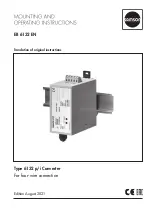
Black Box®LB1350A/LB1351A
26
Advanced status
A port’s advanced status includes, in addition to its number and type:
•
Tag insertion mode (Yes/No)
•
Tag stripping mode (Yes/No)
•
Port’s VID (0-4095)
•
Port based priority (Yes/No)
•
802.1p based priority (Yes/No)
•
TOS based priority (Yes/No)
•
Port’s user priority (0-7)
When tag insertion is enabled on a port it means that any untagged frames coming out
that port will be tagged. The inserted tag will include the ingress port’s VID and user
priority. For example, if port 1’s VID is set to 100 and its priority is set to 4 and the FO
port’s tag insertion is on, then any untagged frame coming on port 1 and going out the
FO port will carry a tag with VID 100 and priority 4.
When tag stripping is enabled, any tagged frame coming on the port, will lose its tag.
Default values are all 0s or No.
The Black Box® LB1351A supports 2 levels of traffic priority: high and low. The
different priority settings enable or disable 3 different types of priority schemes: port
based, 802.1p based and Type Of Service (TOS) based, dealing with DSCP (Diff Serve
Code Points) field values.
When more than one scheme is enabled, priority conflicts are resolved by the following
order: 802.1p based priority overrides port based priority and TOS based priority
overrides 802.1p based priority. Default values are all No.
Please note that the advanced port settings apply to management traffic as well.
Management can be thought of as a virtual, internal port.
The
device’s advanced status
consists of:
•
Test mode (FEF disable/enable)
•
Priority ratio (always hi/10:1/5:1/2:1)
•
Broadcast protection (allow 25/12/6/3%)
•
DSCP codes (64 bits)
•
User priority classification (7 priority codes, set as high or low priority)
The test mode is used mainly for maintenance purposes and its meaning is that the
FEF function is disabled (when Test is On). Default value is Test Off.
The priority ration setting controls the priority traffic flow ratio. If for example, set to
always hi, all high priority frames will be forwarded before low priority ones. At 10:1,
after every 10 high priority frames, a single low priority frame will be forwarded and so
on. Default value is always hi.













































